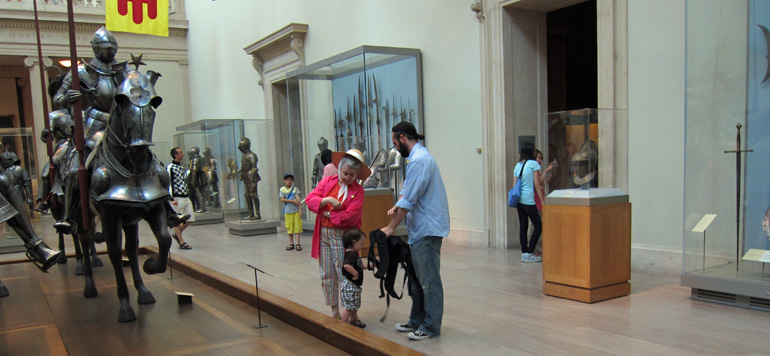Gotham Diary:
Reopening
28 October 2011
The Islamic Wing at the Museum re-opened the other night, finally, after years and years of reconstruction and refurbishment — not only of the Wing itself but of the Greek and Roman Galleries upon which it sits. I didn’t bring my camera; taking pictures would have been gauche. Once the rooms are open to the general public, I’ll snap away. For the moment, this souvenir of what I think was Will’s most recent visit to the Museum will have to do.
It’s not called the “Islamic Wing” anymore (if it ever was); it’s now the “Galleries for the Art of the Arab Lands, Turkey, Iran, Central Asia and Later South Asia.” That’s the last time you’re going to hear that mouthful from me. Holland Cotter is doubtless correct when he observes, “
Rather than presenting Islamic art as the product of a religiously driven monoculture encompassing centuries and continents, the Met is now — far more realistically —approaching it as a varied, changing, largely secular phenomenon, regionally rooted by absorptively cosmopolitan, affected by the intricacies and confusions of history, including the history that the art itself helped to create.”
But there’s no getting round the fact that this art is bound by a pervasive appreciation of calligraphy that has its roots in a highly articulate religious authority — nor the other fact, less salient within the galleries themselves but pronounced in the small graphic indicating the small corner (relative to the immense corner of the American Wing, say) of the Museum in which they sit. How do you justify sequestering all those bits and pieces from Arab Lands and Turkey and Iran and Central Asia and Later South Asia into a space that would fit within the vast chamber that houses the Temple of Dendur? Traadition is a big part of it — the same tradition that tempted the Times to run its inexcusable headline for Cotter’s review: “A Cosmpolitan Trove of Exotic Beauty.” I think that it’s safe to say that we live in times when the word “exotic” is enjoying a time-out from grown-up usage.
The other odd thing about the installation is that the most magnificent artifact in it is not only brand-new but purpose-built. The Moroccan Court is a work of art, no doubt about it, a breathtaking sculpture in plaster, tile, and wood that was completed last spring by a company of craftsman from Morocco. It is a triumph of earthen apotheosis that exploits no rare or precious resources — except, of course, the diligent inspiration of the men who built it. I’ll write later about the galleries’ treasures that appealed most to me, but for the moment I’m most taken by the new development in museum history that the Moroccan Court represents. (The Astor Court, certainly a harbinger, does not work on anything like the same “fantastically filigreed” level.) Puzzling out the nature of its novelty will be keeping a gaggle of neurons busy for a while. Â
***
Will had had a long day by the time I showed up to babysit. He’d been to the doctor for his 21-month checkup (pushing 22), and he’d gone back to school for a birthday party. By 6:30, all he wanted to do was sit in someone’s lap, drink milk, and watch Sesame Street. Later, when the pizza arrived, and there were no available laps, he sat in the big chair by himself and ignored me. He didn’t want any pizza — that was no surprise — but he also didn’t want to acknowledge my presence. His focus on the television wasn’t stony, quite, but it was certainly very determined. Determined by fatigue, I believe, even if it did exactly resemble a teenager’s desperately willful obliviousness.
Then the episode came to an end, and Will perched himself on the arm of the chair, facing me, and said, “Allô.” For the first time in my experience, he said it without talking into some small device that he was pretending to be a telephone (or that might actually be a telephone). And he was saying it to me. It was like Lucy’s sign in Peanuts: “The Doctor Is In.” He got out of the chair, too me by the hand, and led me to his room, where we played with his trains for an hour.Â
Another teen moment: there was a burst of violence. Out of the blue, Will picked up his train cars and threw them about the room (but not at me). When he seemed to have had enough throwing, I suggested that he’d better pick everything up. He smiled archaically and in an angel-biscuit voice said “‘Kay,” and very conscientiously picked up each one of his sometime projectiles.
A further teen moment: he fell asleep, without a fuss, while I was in the room. They used to tell me, when I was little, that I was a good boy — when I was asleep. We were somewhat surprised to learn that Will is no longer in the 99th percentile for height; he has dropped to the 97th. (Megan almost demanded a recount.) But he’s in the 99th percentile for niceness, even when he’s awake. His parents are in the 99th percentile of the leading categories as well.

